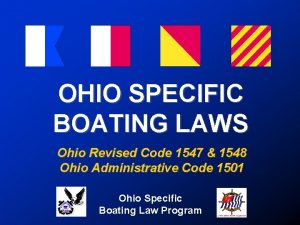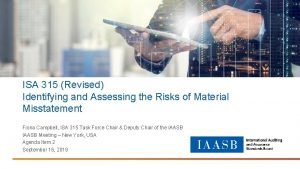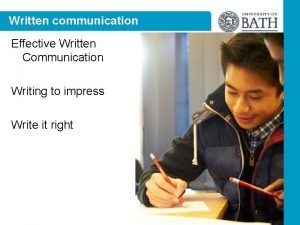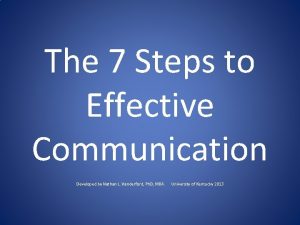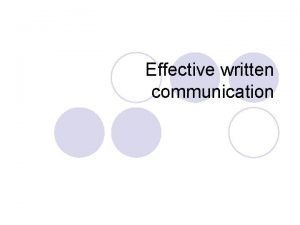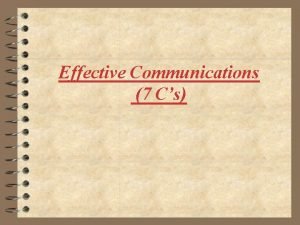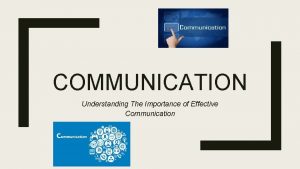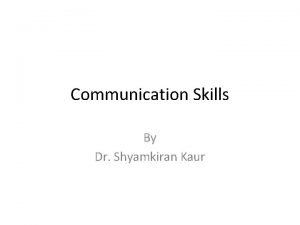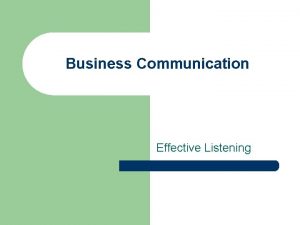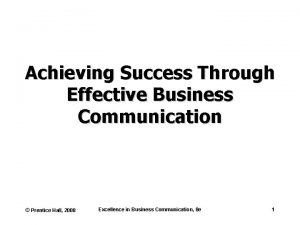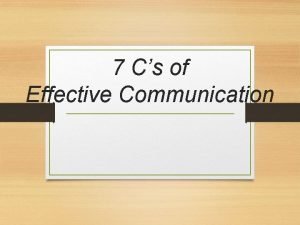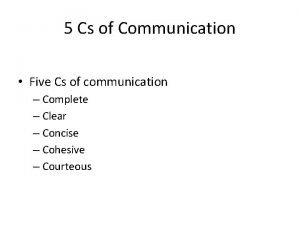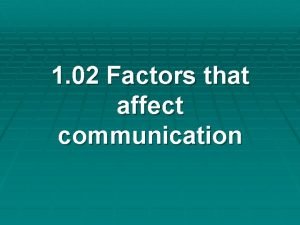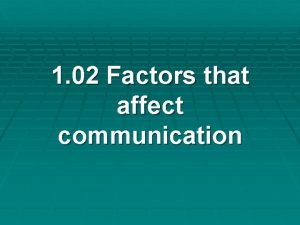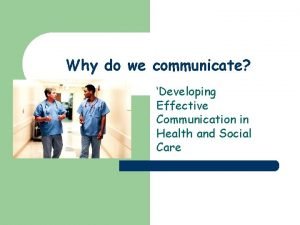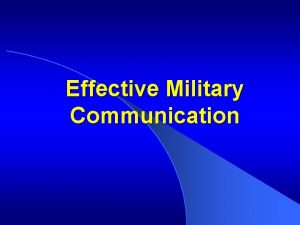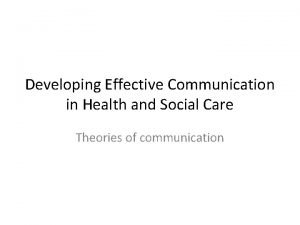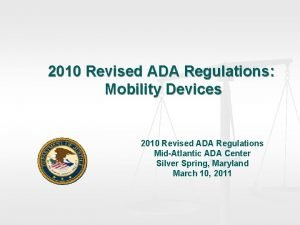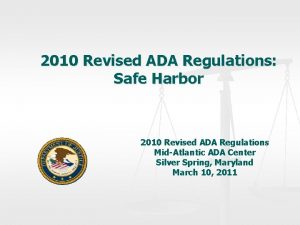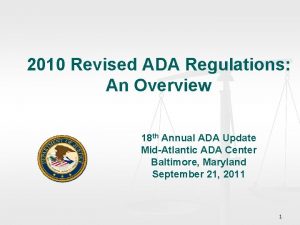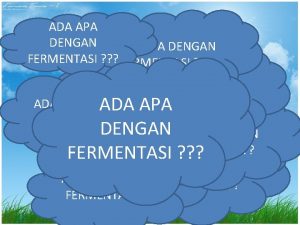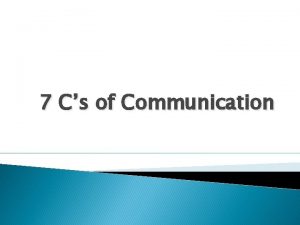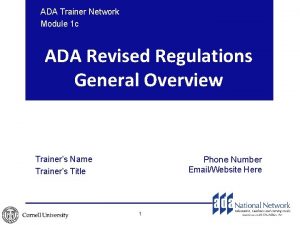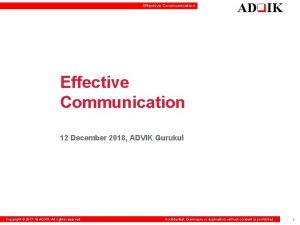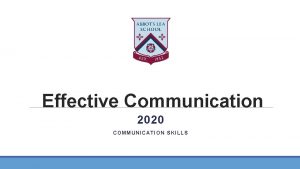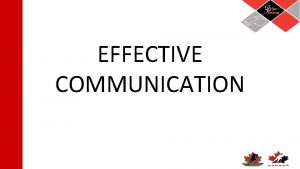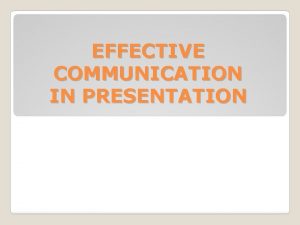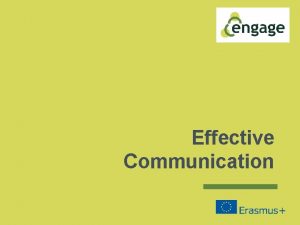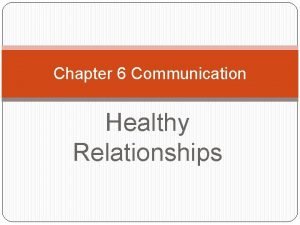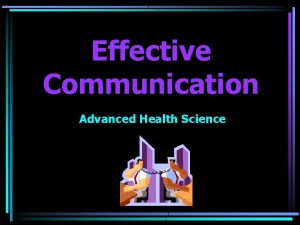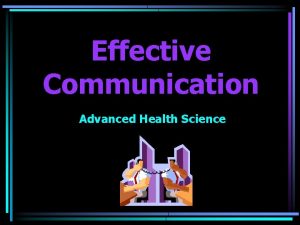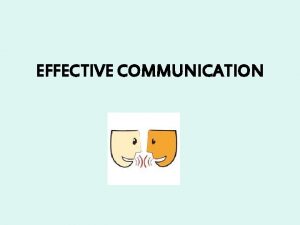2010 Revised ADA Regulations Effective Communication 2010 Revised
























- Slides: 24

2010 Revised ADA Regulations: Effective Communication 2010 Revised ADA Regulations Mid-Atlantic ADA Center Silver Spring, Maryland March 10, 2011

Title II Generally n n Title II entities must take appropriate steps to ensure that communications with individuals with disabilities are “as effective” as communications with others Includes providing appropriate auxiliary aids and services “where necessary”

Communication with everyone ADA requires communication with everyone, not just “primary” communicator n Medical: deaf spouse of hearing patient n Court: not just parties; also jurors, spectators n Anyone who would be able or eligible to communicate or participate in the activity

Individuals with Disabilities n n n Individuals who are deaf or hard of hearing Individuals who are blind or have low vision Individuals who have speech-related impairments

Auxiliary aids and services for individuals who are deaf or hard of hearing Qualified interpreters n Notetakers n Transcription services n Written materials n Telephone handset amplifiers n Assistive listening systems n

For individuals who are deaf or hard of hearing (Part II) Telephones compatible with hearing aids n Closed captioned decoders n Open and closed captioning n TDDs / TTYs n Videotext displays n VRS/VIS n Other effective methods n

Auxiliary aids and services for individuals who are blind or have low vision Qualified readers n Taped texts n Audio recordings n Brailled materials n Large print materials n Electronic/text formats n Other effective methods n

Qualified Reader “Qualified reader” defined as “a person who is able to read effectively, accurately, and impartially, using any necessary specialized vocabulary. ”

Qualified Interpreter “Qualified interpreter” defined as “An interpreter who, via video remote interpreting (VRI) service or an on-site appearance, is able to interpret effectively, accurately, and impartially, both receptively and expressively, using any necessary specialized vocabulary. Includes sign language interpreters, oral transliterators and cuedlanguage transliterators.

Revisions to Effective Communication Requirements n n Companions with disabilities Discussion of types of auxiliary aids and services that are necessary to ensure effective communication Limitations on use of individual accompanying person with a disability as an interpreter. Requirements for video remote interpreting services

Companions n n Covered entities must communicate effectively with companions with disabilities, as appropriate. Companion defined as “family member, friend, or associate of an individual seeking access to a service, program or activity of a public entity, who along with such individual is an appropriate person with whom the public entity should communicate. ”

Types of Auxiliary Aids or Services: What Works and When? n n Type of auxiliary aid or service will vary in accordance with: n Method of communication used by individual; n Nature, length, and complexity of communication involved; and n The context in which communication is taking place. Provide auxiliary aids in accessible formats, in timely manner, and in manner that protects privacy and independence of individual.

Use of Adults Accompanying Individual With a Disability n n Public entities shall not require individual to bring own interpreter. Public entities shall not require adults accompanying individual to interpret except: n In emergency involving imminent threat to safety or welfare of individual or public and no interpreter available, or n Where specific request by person with disability, accompanying adult agrees, and reliance on that person is appropriate under circumstances.

Use of Children as Interpreters Only permissible in emergency involving imminent threat to safety or welfare of an individual or the public where there is no interpreter available.

Video Remote Interpreting Definition: An interpreting service that uses video conference technology over dedicated lines or wireless technology offering high-speed, widebandwidth video connection that delivers high -quality video images…

Video Remote Interpreting Continued DOJ standards require: n Quality of video and audio that is high quality, clear, real-time, with clear uninterrupted images. n Dedicated high-speed connection. n Picture: Clear, sufficiently large, and sharply delineated, showing face, arms, hands and fingers n Voices: clear and easily understood transmission. n Quick set-up and training of users.

Use of Automated Attendant Systems n n These include automated voice mail, interactive voice response systems. If provided, must ensure effective communication in real time with individuals using auxiliary aids and services (TTY’s, TRS).

Telecommunications Relay Services Entity must answer telecommunications relay calls in same manner as it answers others.

Title II: Primary consideration n In determining what type of auxiliary aid and service is necessary, a public entity shall give primary consideration to the requests of the individual with disabilities.

Fundamental Alteration An entity is not required to provide an auxiliary aid or service if it would fundamentally alter the nature of the program or service.

Fundamental Alteration: Part 2 A public entity is not required to take action if it would result in undue financial and administrative burdens. n Look at resources of the agency as a whole. n Still required to provide service to the maximum extent possible.

TTYs n Encouraged where there is extensive telephone contact with the public n Required for emergency responders

Surcharges Not Permitted A covered entity may not place a surcharge on a particular individual with disabilities or a particular group of individuals with disabilities to cover the cost of providing auxiliary aids and services.

Resources n ADA Information Line (DOJ): n n n 1 -800 -514 -0301 (v); 1 -800 -514 -0383 (tty) ADA Website (DOJ): n www. ada. gov Disability & Business Technical Assistance Centers (“DBTAC”): n 1 -800 -949 -4232
 Ohio revised code reckless operation
Ohio revised code reckless operation Environmental permitting regulations 2007
Environmental permitting regulations 2007 Isa 315 revised
Isa 315 revised Gaya terdiri dari tarikan
Gaya terdiri dari tarikan Dalam laporan percobaan tidak ada urutan waktu tetapi ada
Dalam laporan percobaan tidak ada urutan waktu tetapi ada Negasi dari jika ada gula maka ada semut adalah
Negasi dari jika ada gula maka ada semut adalah Effective written communication
Effective written communication 7 steps to effective communication
7 steps to effective communication The 5 inevitable laws of effective communication
The 5 inevitable laws of effective communication Five factors that influence communication
Five factors that influence communication Effective written communication
Effective written communication Courteous message stems from
Courteous message stems from What does effective communication look like
What does effective communication look like Slidetodoc.com
Slidetodoc.com Effective communication definition
Effective communication definition Effective communication examples
Effective communication examples Business communication listening
Business communication listening Competing messages communication barriers
Competing messages communication barriers 7cs of communication assignment
7cs of communication assignment What are the 5 c's of effective communication
What are the 5 c's of effective communication What are the factors that affect communication
What are the factors that affect communication Factors that affect communication
Factors that affect communication One way communication is
One way communication is Effective military communication
Effective military communication Argyle communication cycle
Argyle communication cycle
